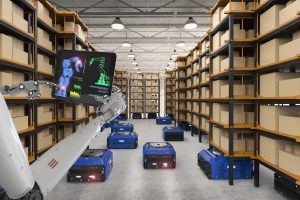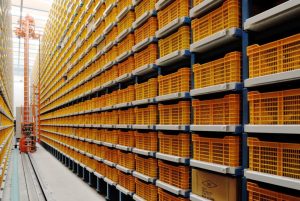Researchers at the University of Illinois has found that while the automation of warehouse tasks won’t replace human jobs in the short-term, it will make their jobs harder. The thinking goes that technology, in the form of goods-to-person solutions, sensors and warehouse management systems are increasing the pressure on operatives to “work harder, faster and under more scrutiny”. The report argues that the results could be harmful to workers, despite boosting productivity.
Shirin Ghaffary, at Recode (link to full article) makes several interesting points in her analysis of the report and whilst it focuses its attention on the US, it is generally very applicable to the UK.
Which tasks can be automated?
All sorts of warehouse tasks can be automated or mechanised in some way. The most common targets for automation, however, are where processes are labour intensive or there are time pressures to meet customer expectations.
The growth of eCommerce and online fulfilment has resulted in a more fragmented order profile, increasing the distance walked for traditional manual pick operations. It has also created a significant operation in packing customer orders into individual parcels. These two functions can easily account for over 50% of warehouse labour hours in pure-play and omnichannel fulfilment operations, so are prime targets for automation.
How are they automated?
Picking is automated by implementing systems that bring the products required by customers to the picker, saving travel time by the pick operative. This is commonly known as goods-to-person picking. Automated packing can range from the building and closing of a carton to the wrapping and sealing of a parcel.
There are a whole range of other ways that processes can be automated with the introduction of AGV’s (Autonomous Guided Vehicles) or conveyor to transfer loads from one location to another, drones to perform cycle counts, label printers to add identifiers and more.
Will automation technology make work harder?
When automation is deployed well, it should not make work harder for employees, but it will add focus to the value-added parts of the process:
- Automation can replace manual and repetitive physical processes, leading to safer working conditions with fewer injuries, caused by excessive walking, lifting or twisting.
- Equipment manufacturers take great care in the design of the touch points where people interact with technology. Ergonomic workstations minimise physical stresses by carefully locating the equipment required to fulfil each task.
- Warehouse automation focuses employees on specific tasks by removing certain aspects of the task; a picker still picks, but they can pick more because they spend less time walking. Goods-to-person solutions can increase productivity from 100-150 lines per hour to 400-600 lines per hour.
- Technology captures data wherever it is deployed but how that data is used is where good management becomes essential. Realistic productivity targets that preserve employee well-being must be set with experts whilst optimisation must focus on the process, not the individual.
- Variability is also key to a good working environment – some manufacturers recommend only spending half a shift at a goods-to-person pick station with the remaining time performing other tasks such as loading vehicles, fork-lift tasks, packing etc.
[visual-link-preview encoded=”eyJ0eXBlIjoiZXh0ZXJuYWwiLCJwb3N0IjowLCJwb3N0X2xhYmVsIjoiIiwidXJsIjoiaHR0cHM6Ly93d3cueW91dHViZS5jb20vd2F0Y2g/dj1RMkZQZjBmZkFlMCIsImltYWdlX2lkIjotMSwiaW1hZ2VfdXJsIjoiaHR0cHM6Ly9pbWcueW91dHViZS5jb20vdmkvUTJGUGYwZmZBZTAvc2RkZWZhdWx0LmpwZyIsInRpdGxlIjoiVGhlIFRha2VvZmYgQ2hhbGxlbmdlOiBNYW51YWwgdnMuIEF1dG9tYXRlZCBQaWNraW5nIC0gWW91VHViZSIsInN1bW1hcnkiOiJXaG8gY2FuIHBpY2sgYW4gb3JkZXIgb2YgdGVuIGl0ZW1zIGZhc3RlcjogYSBtYW51YWwgcGlja2VyLCBvciBUYWtlb2ZmPyBUYWtlb2Zm4oCZcyBhdXRvbWF0ZWQgc29sdXRpb24gaXMgMTAgdGltZXMgZmFzdGVyIHRoYW4gbWFudWFsIHBpY2tpbmcuIFZpc2l0IHRha2VvZmYuY29tIHRvIGZpbmQgb3V0IGhvdyB3ZSBhcmUgaGVscGluZyBncm9jZXJ5IHJldGFpbGVycyBmdWxmaWxsIG9ubGluZSBvcmRlcnMgaW4gYSBmcmFjdGlvbiBvZiB0aGUgdGltZS4iLCJ0ZW1wbGF0ZSI6InVzZV9kZWZhdWx0X2Zyb21fc2V0dGluZ3MifQ==”]
Will robots replace people in warehouses?
- Full automation is unlikely to be operating at an industry wide scale within the next decade – the number of operations that do not rely on people is still, relatively speaking, very small.
- Not all processes are easily automated – for example, unit picking has advanced massively in the last five years but even with machine learning and AI, people are still more capable of dealing with the greater variability of products and tasks; showing just how impressive the human body is.
- When robots do replace humans, the lost jobs will be replaced to some degree with higher skilled roles to manage projects and the operation while performing maintenance on the robots.
Technology will continue to transform the nature of warehouse work, but BoxLogic believes that this is not something to be feared. We have largely had good feedback from warehouse staff, excited at the prospect of a forthcoming automation project or positive about the relative ease of tasks after go-live. It is the duty of the adopters of any technology to use it responsibly and sustainably.
If you’re considering automation in your operation then get in touch with experts by emailing enquiries@box-logic.co.uk or interact with our chat robot! We look forward to hearing from you.



